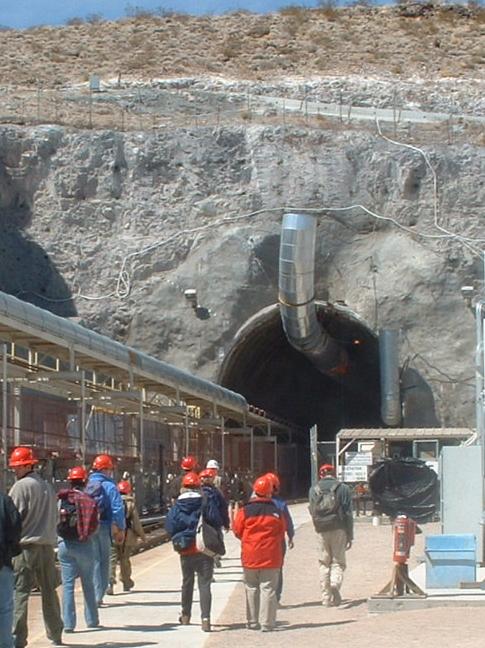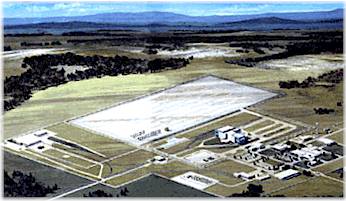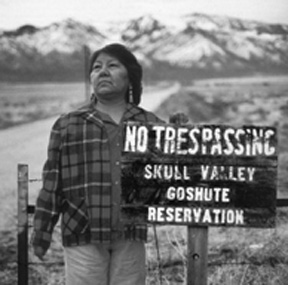News from Yucca & PFS
February 23rd, 2006
Yes, it is certainly Nuclear Waste Daze all over again.
This from today’s Las Vegas Review Journal, reminds me of Sunday nights at the Magic Wand with eggs and dilled potatoes while they washed the truck before the run down the hill to LA… oh… where was I… nuclear waste, Las Vegas Review Journal:
Yucca feeling heat on humidity: Stop work order prompted by failure to calibrate gauges
By KEITH ROGERS
REVIEW-JOURNALAnother problem has surfaced in the scientific work that is supposed to ensure the safety of entombing the nation’s most lethal nuclear waste in Yucca Mountain.
A spokesman for the project confirmed Wednesday that concerns by nuclear regulators about flawed humidity measurements in corrosion-rate studies of the metal waste disposal packages have prompted them to order a halt to that work.
The stop-work order took effect Jan. 30, about three weeks after inspectors from the Nuclear Regulatory Commission’s safeguards office wrote to the project’s licensing director to say that the work was based on humidity gauges that weren’t calibrated. Project contractor Bechtel SAIC had claimed that the work was “technically sound” with “defensible results.”
The revelation comes nearly a year after the Energy and Interior departments revealed that several U.S. Geological Survey hydrologists had exchanged e-mails discussing “fudge factors” and possible falsification of quality assurance documents on water infiltration research.
Bob Loux, executive director of Nevada Nuclear Projects Agency and a leading critic of the government’s effort to dispose of spent nuclear fuel at Yucca Mountain, 100 miles northwest of Las Vegas, said the latest revelation means the project’s entire quality assurance program is flawed.
“This strikes right in the heart of the whole corrosion issue. If some of the data is suspect, it’s huge,” Loux said.
Steve Frishman, a full-time consultant for the Nevada Nuclear Projects Agency, said that if they used improperly calibrated or uncalibrated equipment, government scientists might have underestimated corrosion rates of the nickel alloy, known as Alloy-22, that will be the outer cover of the stainless-steel waste packages. The packages are supposed to contain 77,000 tons of spent fuel assemblies and highly radioactive defense wastes in a maze of tunnels inside the mountain.
“They did not only not follow their quality assurance measures, they also didn’t follow the scientific procedures for the experimental work. … It isn’t science if quality assurance isn’t there,” Frishman said.
“Now we have the corrosion rate of the container in question, and because of the USGS stuff we have the infiltration of water in question, and these are two critical pieces of the repository design,” he said.
An investigation into the uncalibrated instruments used in corrosion experiments is under way to determine the root of the problem and what corrective actions must be taken, said Allen Benson, a Department of Energy spokesman for the Office of Repository Development in Las Vegas.
“We take these quality assurance concerns very seriously, and we will look into and address all the concerns raised by the NRC,” Benson said.
He said the investigation will focus on high-temperature humidity instruments called “Vaisala probes,” and “any other instruments at or beyond documented calibration ranges.”
In August, observers from the NRC staff examined an audit by a Bechtel SAIC team into the quality assurance of waste package corrosion experiments conducted between 2002 and 2005 at Lawrence Livermore National Laboratory in California, 45 miles east of San Francisco.
The NRC observers found that:
â?¢ Experiments were started without calibrated instruments.
â?¢ Calibration was not documented.
â?¢ Lawrence Livermore scientists planned to conduct an “in-house” experiment to calibrate the probes and qualify data “after experiments were completed.”
A Lawrence Livermore spokesman deferred comment Wednesday to DOE’s Office of Repository Development.
Benson said the investigation is expected to be completed in late March. Until then, project officials won’t know whether any or all of the Lawrence Livermore work on the corrosion studies will have to be redone.
Sandia National Laboratories currently is redoing the infiltration model, anticipating that the lack of traceable quality assurance documentation of the scientific work will lead to failure to pass the scrutiny of a license application review by the NRC.
As for the corrosion experiments, Frishman said lack of calibration of the humidity instruments would skew results of how dust containing minerals and salts could accelerate the corrosion of the waste packages’ outer shell. Some of the experiments were exploring the impact of “deliquescence,” in which some minerals and salts soak water vapor form the air, creating a corrosive solution.
At a Feb. 1 technical review panel meeting in Las Vegas, scientists estimated that corrosion will take its toll on waste packages after they have been in the mountain for 40,000 to 60,000 years. Water moving through the mountain at first would be driven away by heat from the decaying waste, but eventually moisture would condense and infiltrate the tunnels, carrying off deadly, long-lived radioactive materials.
While the news was breaking about the calibration issues Wednesday, state Attorney General George Chanos and members of the statewide environmental group Citizen Alert met in Las Vegas with Minnesota legislators who wanted to hear the state’s concerns on Yucca Mountain before touring the site today.
“Our new attorney general said as long as he is attorney general, Yucca Mountain is not going to happen,” said Peggy Maze Johnson, executive director of Citizen Alert.

==============================================================================
And there’s also Private Fuel Storage in the News:

Proposed PFS site at Skull Valley Goshute Reservation
Today in the Christian Science Monitor.
Is used nuclear reactor fuel headed for the reservation?
By Faye Bowers | Correspondent of The Christian Science Monitor
SKULL VALLEY GOSHUTE RESERVATION, UTAH â?? It’s a question that has dogged the nuclear industry since the 1970s: What can it do with spent fuel rods?
The radioactive waste, eventually slated for permanent storage at a still unfinished site in Nevada, has been piling up, mostly at the nation’s 65 commercial nuclear power plants. Late Tuesday, the Nuclear Regulatory Commission (NRC) gave its blessing to a solution: a storage site on a barren patch of a reservation in Utah that’s home to some 25 native Americans, next to a proving ground for chemical and biological weapons, and near an Air Force bombing range.
The NRC licensed what would be the nation’s largest – and only private – nuclear-waste storage facility. A consortium of utility companies would store for up to 40 years some 40,000 metric tons of spent nuclear fuel for an industry rapidly running out of space.
But the plan has powerful opponents, including Utah’s entire congressional delegation and its governor, who have developed a multipronged attack plan to try to beat back this latest effort.
“Our position is this represents public policy at its absolute worst,” says Mike Lee, general counsel to Utah Gov. Jon Huntsman Jr. “What these people want to do is take spent nuclear fuel and put it above ground in casks in a valley that’s located 40 miles immediately upwind from Utah’s only population center. To make matters much worse, this aboveground, open-air facility lies immediately under the low-altitude flight path of 7,000 F-16s a year en route to a bombing range.”
But it is precisely those conditions that make the reservation land unfit for most anything else, says Leon Bear, chairman of the Skull Valley Goshute Reservation. In addition, Utah has outlawed gambling in the state, so the Goshutes can’t open a casino. That is one reason the tribe leased 840 acres of its sprawling reservation for an undisclosed sum to Private Fuel Storage (PFS), the consortium that would house the nuclear fuel rods.
“What do they think we can do, sell bottled water?” Mr. Bear asks.
Standing on a hill, where small mounds of snow-covered Great Basin sage and rabbit bush stretch as far as the eye can see, he explains his vision. It includes the return to this 18,000-acre reservation of many of his small band of 123 Goshutes. They would join the 25 or so who currently live here because the deal would provide enough money for decent housing, education, a cultural center, and healthcare – and spin off several jobs as well.
The tribe’s efforts to land a nuclear storage facility date back to the late 1980s, when Mr. Bear’s father, Richard, and uncle, Lawrence, began to look into the process and the risks involved.
Mainly with grants from the Department of Energy, and financial backing from PFS, which is also paying most of the tribe’s legal fees for pushing this project, Bear and a few others from the tribe have toured spent nuclear storage facilities in England, France, Sweden, and Japan. They’ve also visited the two federal aboveground storage facilities, in Idaho and Minnesota.
But the state’s public servants say they worry that, with all the delays and problems involved with opening the permanent storage site at Nevada’s Yucca Mountain, the proposed temporary storage site at Skull Valley may become a permanent one. And they are pursuing multiple options to derail the project.
For example, Rep. Rob Bishop (R) of Utah was able to include a measure to declare lands around the reservation national wilderness area in the Defense Authorization bill that passed in December. That effectively stops PFS from building a rail spur into Skull Valley Reservation from the main railroad parallel to Interstate 80, about 33 miles north of the reservation. That will force PFS to find an alternative transportation method, which will require the Bureau of Land Management (BLM) issue rights of way. The governor’s office plans to lobby the BLM so it won’t issue them.
Moreover, the state has one more chance to stop the effort by appealing to the Bureau of Indian Affairs, according to Mr. Lee of the governor’s office. The BIA must approve the lease agreement between PFS and the reservation.
Such moves are only the latest by opponents, which include environmentalists and even members of the Goshute tribe. They have waged a protracted nine-year battle to prevent the reservation from taking possession of the dry-storage casks containing spent nuclear fuel, and don’t plan to give up their fight anytime soon.
Margene Bullcreek, leader of PFS opposition at Skull ValleyThe Bears, for their part, say they are patient, and that this effort is only a continuation of the Goshutes being good neighbors, good hosts. When they’ve been asked to host other government projects, such as a rocket motor testing program, or the storage of solid waste from Salt Lake City, they’ve done it.
“Whenever we’ve been asked to go to war for this country, or to host something, we have been willing to help as long as they have asked,” says Tomy Bear, Leon Bear’s wife.

Leave a Reply